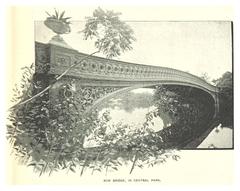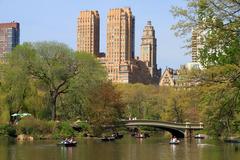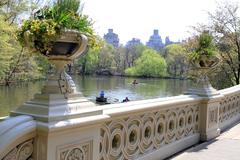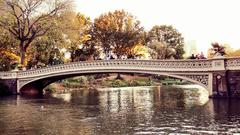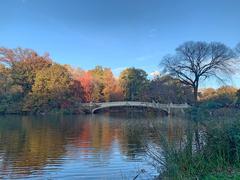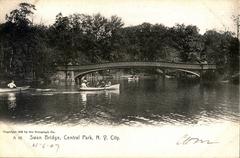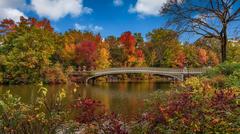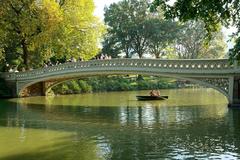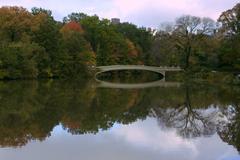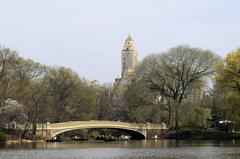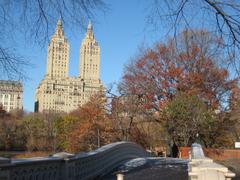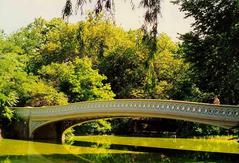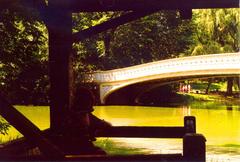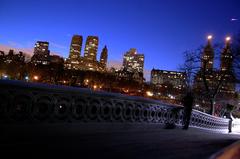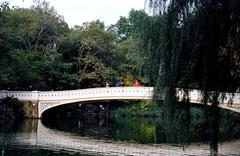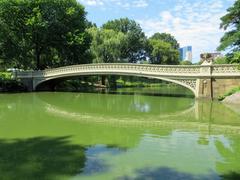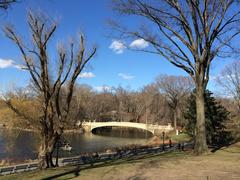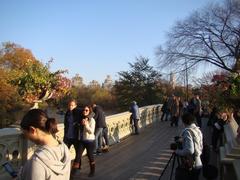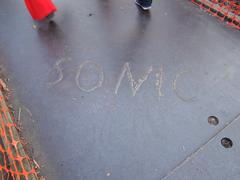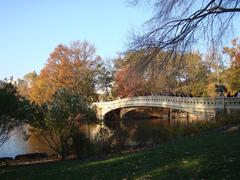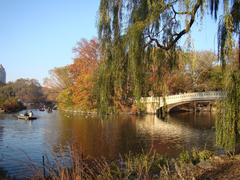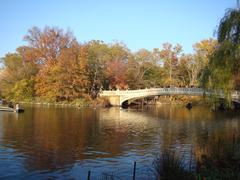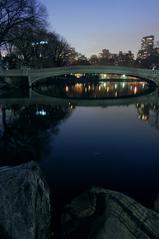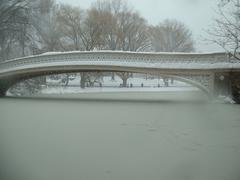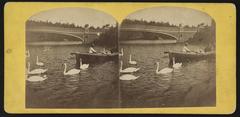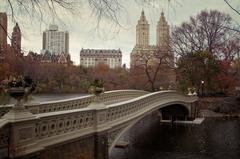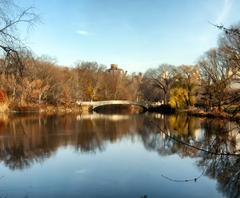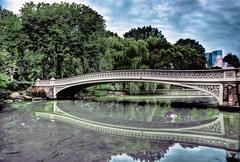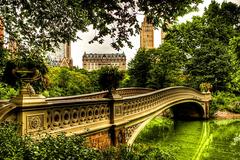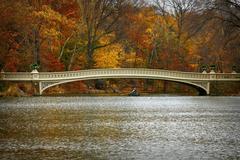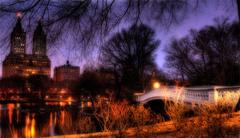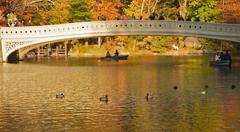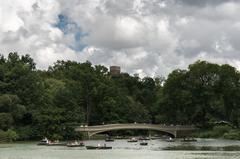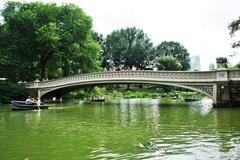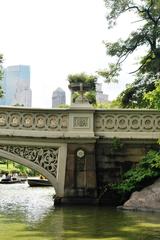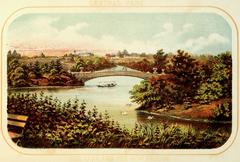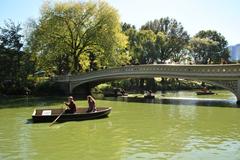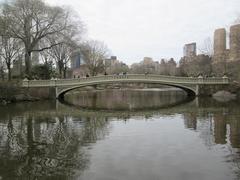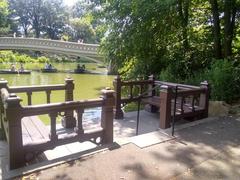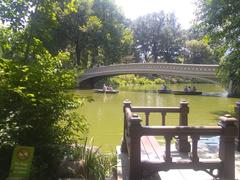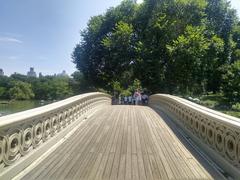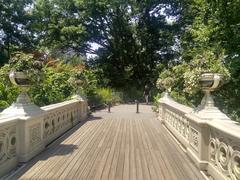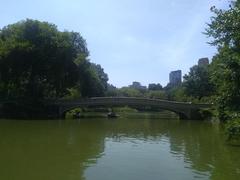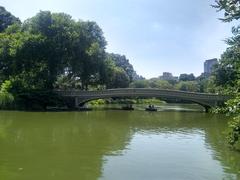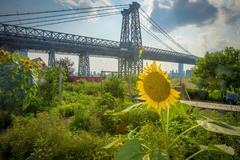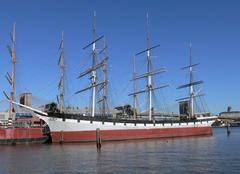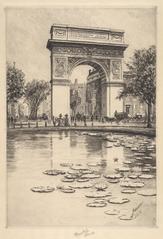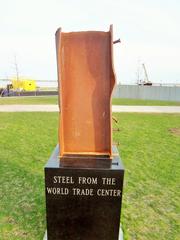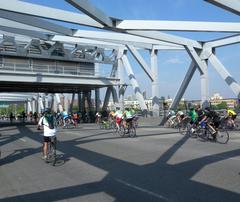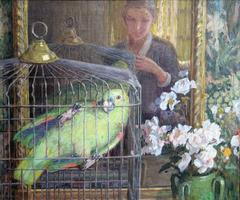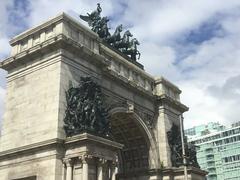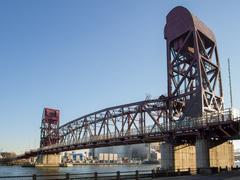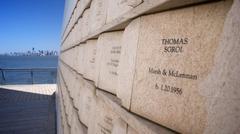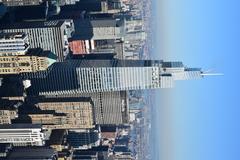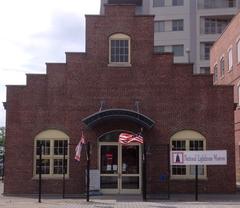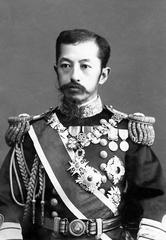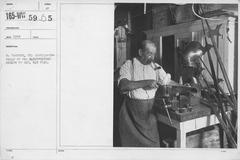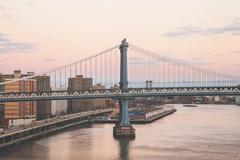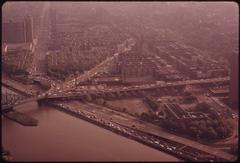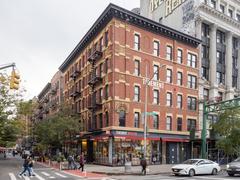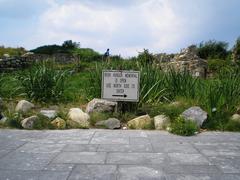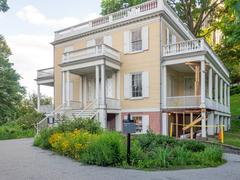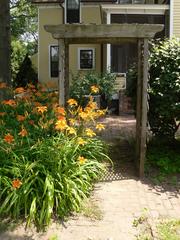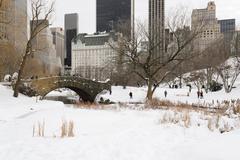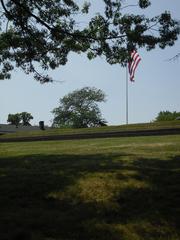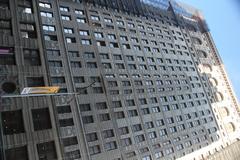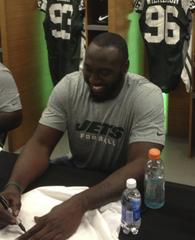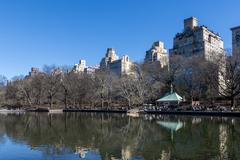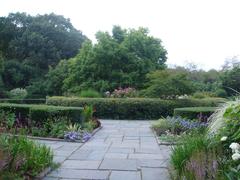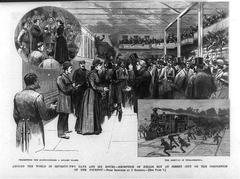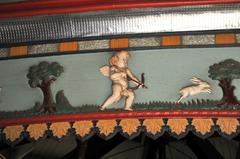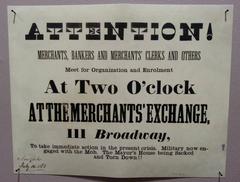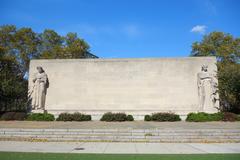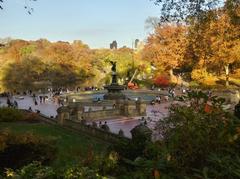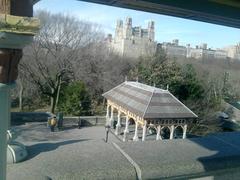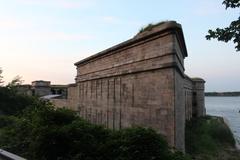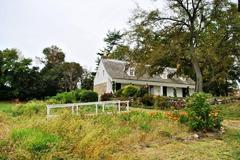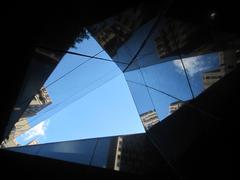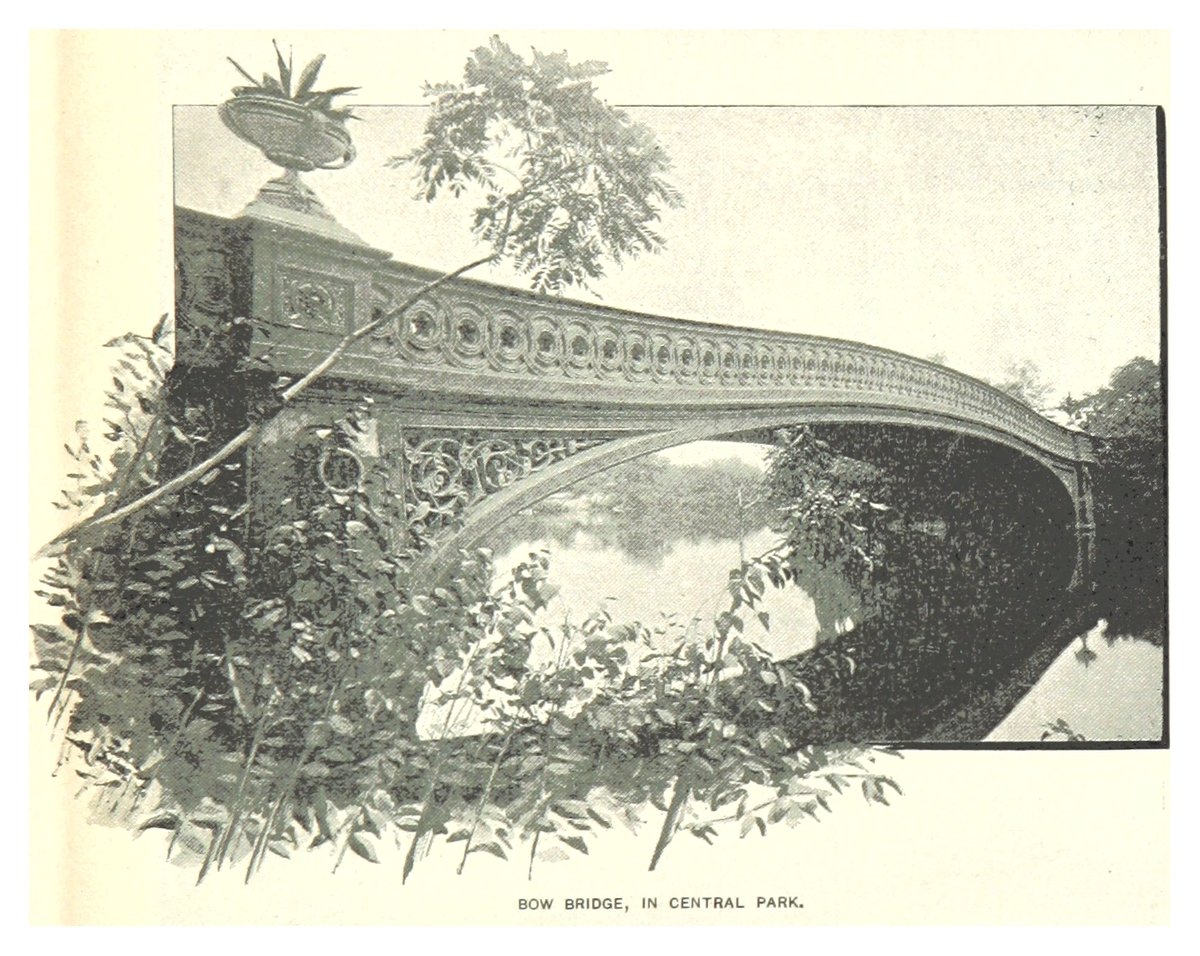
Visiting Bow Bridge in Central Park: Hours, Tickets, and Tips
Date: 19/07/2024
Introduction to Bow Bridge
Bow Bridge, nestled in the heart of Central Park, New York City, is an architectural gem and cultural landmark. Designed by Calvert Vaux and Jacob Wrey Mould, the bridge was completed in 1862 and is celebrated for its graceful cast-iron structure and intricate design inspired by classical Greek architecture. Spanning 60 feet across the Central Park Lake, Bow Bridge connects Cherry Hill with the Ramble, offering picturesque views and serving as a beloved spot for romantic walks, photography, and leisurely activities (Central Park Conservancy). The bridge’s name, derived from its resemblance to an archer’s bow, underscores its aesthetic and structural elegance. As part of the original vision for Central Park by Frederick Law Olmsted and Calvert Vaux, Bow Bridge was intended to provide a serene escape in the midst of urban New York, embodying the park’s mission to offer a democratic space for all (The Cultural Landscape Foundation). Over the years, Bow Bridge has not only stood as a testament to 19th-century engineering and design but has also become a cultural icon, appearing in numerous films and television shows and serving as a backdrop for countless wedding proposals and photo shoots (NYC Parks). This guide provides a comprehensive look at the history, architectural significance, visitor information, and tips for making the most of your visit to Bow Bridge.
Table of Contents
- Introduction
- Architectural Significance
- Construction and Materials
- Historical Context
- Restoration Efforts
- Cultural Impact
- Notable Events
- Preservation Challenges
- Visitor Information
- Future Prospects
- Conclusion
- FAQ
- Essential Tips for Visiting Bow Bridge
Exploring Bow Bridge - History, Visitor Information, and Tips for Your NYC Visit
Introduction
Bow Bridge is not just an architectural marvel but also a cultural icon nestled in Central Park, New York City. This article will take you through the history of Bow Bridge, provide essential visitor information, and offer tips to make the most of your visit. Whether you’re a history enthusiast or simply looking for picturesque spots in NYC, Bow Bridge is a must-visit destination.
Architectural Significance
Bow Bridge, an iconic cast-iron bridge in Central Park, New York City, was designed by Calvert Vaux and Jacob Wrey Mould and completed in 1862. It is renowned for its elegant design and intricate details. The bridge spans 60 feet across the Central Park Lake, connecting Cherry Hill with the Ramble. Its design was inspired by classical Greek architecture, featuring a graceful arch and detailed moldings. The bridge’s name is derived from its resemblance to an archer’s bow, a testament to its aesthetic appeal and structural ingenuity (Central Park Conservancy).
Construction and Materials
Bow Bridge was constructed using cast iron, an innovative material choice for its time. The use of cast iron allowed for the creation of intricate designs and ensured the bridge’s durability. The bridge’s deck is made of ipe, a South American hardwood known for its strength and resistance to weathering. This combination of materials has contributed to the bridge’s longevity and its status as a beloved landmark in Central Park (NYC Parks).
Historical Context
The construction of Bow Bridge occurred during a period of significant development in New York City. Central Park itself was a groundbreaking project, designed to provide a green oasis in the rapidly urbanizing city. The park’s designers, Frederick Law Olmsted and Calvert Vaux, envisioned it as a democratic space where people from all walks of life could enjoy nature. Bow Bridge was an integral part of this vision, serving as both a functional crossing and a picturesque viewpoint (The Cultural Landscape Foundation).
Restoration Efforts
Over the years, Bow Bridge has undergone several restoration efforts to preserve its structural integrity and aesthetic beauty. In the 1920s, the bridge’s original wooden deck was replaced with concrete, which was later restored to wood in the 1970s to maintain historical accuracy. The most recent restoration, completed in 2008, involved extensive repairs to the bridge’s ironwork and the replacement of the wooden deck with sustainably sourced ipe wood. These efforts have ensured that Bow Bridge remains a cherished landmark for future generations (Central Park Conservancy).
Cultural Impact
Bow Bridge has been featured in numerous films, television shows, and works of art, cementing its status as an iconic symbol of New York City. Its picturesque setting and romantic ambiance have made it a popular location for wedding proposals and photo shoots. The bridge’s cultural significance extends beyond its physical presence, as it represents the enduring appeal of Central Park as a place of beauty and tranquility in the heart of the city (NYC Parks).
Notable Events
Throughout its history, Bow Bridge has been the site of various notable events and gatherings. In the late 19th and early 20th centuries, it was a popular spot for leisurely strolls and social gatherings. More recently, it has hosted events such as concerts, art installations, and community celebrations. These events highlight the bridge’s role as a vibrant and dynamic part of Central Park’s landscape (The Cultural Landscape Foundation).
Preservation Challenges
Maintaining Bow Bridge presents several challenges, including the effects of weathering, foot traffic, and environmental factors. The bridge’s cast-iron structure is susceptible to rust and corrosion, requiring regular maintenance and conservation efforts. Additionally, the high volume of visitors to Central Park necessitates ongoing efforts to protect and preserve the bridge’s delicate features. Despite these challenges, Bow Bridge continues to stand as a testament to the enduring legacy of Central Park’s design and the importance of preserving historical landmarks (Central Park Conservancy).
Visitor Information
For those planning a visit, Bow Bridge is accessible year-round and does not require an entrance fee. The bridge is located near several notable attractions, including Bethesda Terrace and the Central Park Boathouse. Visitors can access the bridge from the nearest subway stations at 72nd Street (B, C lines) and 66th Street (1 line). Early mornings and late afternoons are ideal times for visiting to avoid crowds and capture stunning photographs.
Future Prospects
Looking ahead, the future of Bow Bridge will depend on continued preservation efforts and the support of the community. As Central Park remains a vital part of New York City’s cultural and recreational landscape, Bow Bridge will continue to play a key role in the park’s appeal. Ongoing restoration projects and public engagement initiatives will be essential in ensuring that this historic bridge remains a beloved landmark for generations to come (NYC Parks).
Conclusion
Bow Bridge’s rich history and architectural significance make it a vital part of Central Park’s heritage. From its innovative construction in the 19th century to its ongoing preservation efforts, the bridge stands as a symbol of the park’s enduring appeal and the importance of preserving historical landmarks. As visitors continue to flock to Central Park, Bow Bridge will remain a cherished and iconic feature of New York City’s landscape. Don’t miss the chance to visit this beautiful landmark and explore the many attractions Central Park has to offer.
FAQ
What are the visiting hours for Bow Bridge? Bow Bridge is accessible 24/7.
Is there an entrance fee for Bow Bridge? No, there is no entrance fee to access Bow Bridge.
What is the best time to visit Bow Bridge? Early mornings and late afternoons are ideal for fewer crowds and better photography.
Are there any guided tours available for Bow Bridge? Yes, several guided tours of Central Park include a stop at Bow Bridge. Check with local tour providers.
What nearby attractions can I visit after Bow Bridge? Nearby attractions include Bethesda Terrace, Central Park Boathouse, and Strawberry Fields.
Essential Tips for Visiting Bow Bridge in Central Park, NYC
Best Time to Visit
Bow Bridge, located in Central Park, is a year-round attraction, but the experience can vary significantly with the seasons. Spring (April to June) and Fall (September to November) are particularly beautiful times to visit, with blooming flowers and colorful foliage enhancing the scenic views. Summer (July to August) can be quite crowded, but the lush greenery and warm weather make it a pleasant time for a stroll. Winter (December to February) offers a serene, snow-covered landscape, perfect for a quiet, picturesque visit.
Getting There
Bow Bridge is centrally located in Central Park, making it accessible from various points in Manhattan. The nearest subway stations are the 72nd Street station on the B and C lines, and the 72nd Street station on the 1, 2, and 3 lines. From these stations, it’s a short walk to the bridge. For those preferring to drive, parking can be challenging, so using public transportation or ride-sharing services is recommended.
Navigating Central Park
Central Park is vast, and finding Bow Bridge can be a bit tricky without a map. Visitors can use the Central Park Conservancy’s interactive map to navigate. The bridge is located mid-park at 74th Street, west of Bethesda Terrace. Signage within the park is generally good, but having a map handy can save time.
Photography Tips
Bow Bridge is one of the most photographed spots in Central Park. For the best photos, visit early in the morning or late in the afternoon when the light is softer. The bridge offers stunning views of the Manhattan skyline, especially at sunset. For unique angles, consider taking photos from the water by renting a rowboat from the nearby Loeb Boathouse.
Activities Around Bow Bridge
- Rowboating: Rent a rowboat from the Loeb Boathouse, located nearby. This offers a unique perspective of Bow Bridge from the water. Rentals are available from April through November.
- Picnicking: The area around Bow Bridge is perfect for a picnic. Bring a blanket and enjoy the serene environment. Remember to clean up after yourself to keep the park beautiful.
- Bird Watching: Central Park is a haven for bird watchers. Bring binoculars and a bird guide to spot some of the park’s 230 bird species.
Accessibility
Bow Bridge is accessible to visitors with mobility impairments. The pathways leading to the bridge are paved and relatively flat. However, some areas of Central Park can be uneven, so it’s advisable to plan your route in advance. The Central Park Conservancy provides detailed information on accessible routes and facilities.
Safety and Etiquette Tips
Central Park is generally safe, but it’s always wise to stay alert, especially during early morning or late evening visits. Stick to well-lit paths and avoid secluded areas. The Central Park Conservancy and NYPD patrol the park regularly, and emergency call boxes are located throughout the park. Additionally, respect the environment by not littering, keeping noise levels down, and not feeding the animals.
Nearby Attractions
- Bethesda Terrace and Fountain: Just a short walk from Bow Bridge, this iconic spot features intricate carvings and a beautiful fountain.
- Strawberry Fields: A tribute to John Lennon, this area is located near the west side of the park at 72nd Street.
- The Ramble: A 36-acre woodland area near Bow Bridge, perfect for a nature walk.
Dining Options
- The Loeb Boathouse: Offers a sit-down dining experience with views of the lake. Reservations are recommended, especially on weekends.
- Tavern on the Green: Located on the west side of the park at 67th Street, this historic restaurant offers a variety of dining options.
- Picnic: For a more casual experience, consider bringing your own food. There are several delis and grocery stores near the park where you can pick up supplies.
Weather Considerations
Check the weather forecast before your visit. Central Park can be quite exposed, so dress appropriately for the conditions. In summer, bring sunscreen, a hat, and plenty of water. In winter, wear warm clothing and be cautious of icy paths. Consider downloading a weather app for real-time updates.
Special Events and Visiting Hours
Central Park hosts numerous events throughout the year, some of which take place near Bow Bridge. Check the Central Park Conservancy’s events calendar to see if there are any special events during your visit. These can range from concerts and theater performances to guided tours and fitness classes. Bow Bridge itself is accessible 24/7, but it’s best enjoyed during daylight hours for safety and visibility.
Souvenirs and Memorabilia
For those looking to take home a piece of Central Park, the Central Park Conservancy offers a variety of souvenirs, from apparel to books and home decor. There are also several vendors around the park selling artwork and photographs of Bow Bridge and other iconic locations.
FAQs
Q - Are there any fees to visit Bow Bridge?
A - No, visiting Bow Bridge is free of charge.
Q - What are the best times to avoid crowds?
A - Early mornings and weekdays are generally less crowded.
Q - Is Bow Bridge accessible at night?
A - Yes, but it’s safer to visit during daylight hours.
Q - Can I bring my dog to Bow Bridge?
A - Yes, dogs are allowed on a leash.
By following these tips, visitors can ensure a memorable and enjoyable experience at Bow Bridge, one of New York City’s most beloved landmarks. For more updates and tips, download the Audiala app or follow us on social media!
Summary and Final Thoughts
Bow Bridge remains a vital part of Central Park’s heritage, celebrated for its historical, architectural, and cultural significance. From its innovative 19th-century construction using cast iron to its ongoing preservation efforts, Bow Bridge stands as a symbol of the enduring appeal of Central Park and the importance of maintaining historical landmarks. Whether you are a history buff, a photography enthusiast, or simply seeking a picturesque spot for a leisurely stroll, Bow Bridge offers a unique and memorable experience. As Central Park continues to be a vital green space in New York City, ongoing restoration projects and community support will ensure that Bow Bridge remains a cherished landmark for future generations (Central Park Conservancy). Visiting Bow Bridge not only allows you to appreciate its beauty and historical context but also to explore the many attractions and natural wonders that Central Park has to offer. Don’t miss the opportunity to visit this iconic bridge and immerse yourself in the tranquility and charm of one of New York City’s most beloved locations (NYC Parks).
References
- Central Park Conservancy. (n.d.). Bow Bridge. Retrieved from Central Park Conservancy
- NYC Parks. (n.d.). Bow Bridge Highlights. Retrieved from NYC Parks
- The Cultural Landscape Foundation. (n.d.). Central Park. Retrieved from The Cultural Landscape Foundation
